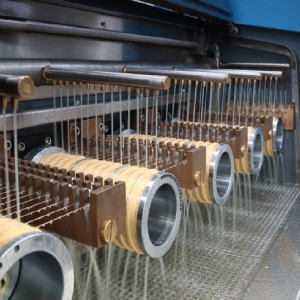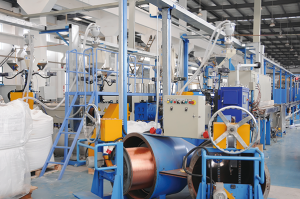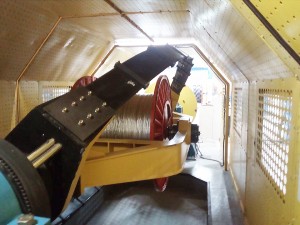1. Drawing and annealing
Wire drawing refers to the process of reducing the section and increasing the length of the copper, aluminum, and aluminum alloy wires through a series of dies with gradually smaller apertures in the wire drawing machine. Wire drawing is generally the first process of wire and cable manufacturing factory.
During the wire drawing process, the wire is deformed by cold working, the strength and hardness increase, but the plasticity decreases. This requires heating the wire to a certain temperature to increase the toughness and reduce the strength of the monofilament by recrystallization. This process is called annealing.
Required equipment: rod breakdown machine (RBD machine), medium wire drawing machine, fine wire drawing machine, multiwire drawing machine, etc.

2. Stranding
In order to improve the softness of cable and facilitate laying and installation, the conductive core is stranded with multiple monofilaments. In order to reduce the cross-sectional area of the wire and reduce the size of the cable, the compact form is generally used while the conductor is stranded, so that the ordinary circle can be semicircle, fan shape, tile shape and compact circle. This type of conductor is mainly used in power cables.
Required equipment: bunching machine, rigid frame strander, tubular stranding machine, concentric stranding machine, etc.

3. Extruding
Wire and cable mainly adopt extruded solid insulation layer, the main technical requirements are as follows.
(1) Eccentricity: The deviation value of the extruded insulation thickness is an important indicator of the extrusion process level.
(2) Smoothness: The surface of the extruded insulating layer is required to be smooth, and there must be no poor quality problems such as surface roughness, burnt, and impurities.
(3) Density: The cross-section of the extruded insulating layer should be dense and firm, without pinholes visible to the naked eye, and to prevent the existence of air bubbles.
Required equipment: insulation extrusion line, etc.

4. Laying up
For multi-core cables, in order to ensure the formability and reduce the external dimensions of the cables, it is generally necessary to twist them into a circular shape.
The technical requirements for laying up. One is to prevent the twisting of the cable caused by the overturning of the special-shaped insulated core. The other is to prevent the insulation layer from being scratched. Most of the cables are cabled with the completion of two other processes. One is filling to ensure the roundness and stability of the cable. The other is binding to ensure that the cable core is not loose.
Required equipment: cradle type cabling machine, drum twister, skip type strander/bow twister, etc.

5. Armoring
The purpose of adding an armored layer is to enhance the tensile strength, compressive strength and other mechanical protection to prolong the service life.
Required equipment: steel tape armoring machine, steel wire armoring machine, etc.
6. Sheath
When wire and cable products are installed and operated in various different environments, there must be a component that protects the product as a whole, especially the insulation layer, which is the sheath. The sheath is used to protect the insulation layer from external damage and moisture intrusion during transportation, laying and use.
Required equipment: sheath extrusion line, etc.
